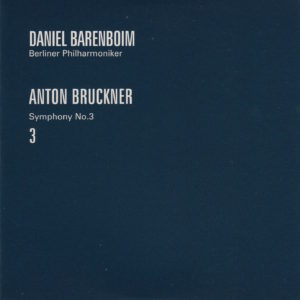 Today, I start another cycle – this time Bruckner’s Bruckner’s Symphony No. 3 in D Minor WAB 103 (nicknamed “Wagner Symphony”), interpreted by Argentine-born pianist and conductor Daniel Barenboim (1942-), whom I saw conduct the Staatskapelle Berlin at Carnegie Hall on January 28th of this year.
Today, I start another cycle – this time Bruckner’s Bruckner’s Symphony No. 3 in D Minor WAB 103 (nicknamed “Wagner Symphony”), interpreted by Argentine-born pianist and conductor Daniel Barenboim (1942-), whom I saw conduct the Staatskapelle Berlin at Carnegie Hall on January 28th of this year.
NOTE: I have two Barenboim CD box sets for this leg of my Bruckner journey. The first (which I’ll call the “Blue Box”) is on the Warner Classics label. The second (which I’ll call the “Pink Box”) is on the Deutsche Grammophon label. The performances in the Blue Box were recorded in the 1990s. The performances in the Pink Box were recorded much more recently, 2012 and 2010.
So…alpha by conductor, then chronological.
That’s the plan.
Because today’s recording comes from the Blue Blox, Barenboim’s orchestra for this performance is the Berliner Philharmoniker. And the music label is Warner Classics, which was awarded “Label of the Year” at the 2016 Gramophone Awards in London last October.
If you want to know what I thought of Maestro Barenboim’s (“Blue Box”) interpretation of Bruckner’s First in this leg of my journey, visit Day 1.
If you want to know what I thought of Maestro Barenboim’s (“Blue Box”) interpretation of Bruckner’s Second in this leg of my journey, visit Day 6.
From its entry on Wikipedia:
The symphony has been described as “heroic” in nature. Bruckner’s love for the grand and majestic is reflected especially in the first and last movements. Stark contrasts, cuts and forcefulness mark the signature of the entire composition. The signal-like trombone thema, heard at the beginning after the two crescendo waves, constitutes a motto for the whole symphony. Many typical elements of his later symphonies, such as the cyclical penetration of all movements and especially the apotheosis at the coda of the finale, which ends with the trombone thema, are heard in the Third for the first time.
The symphony requires an instrumentation of one pair each of flutes, oboes, clarinets and bassoons, with four horns, three trumpets, three trombones, timpani and strings.
According to its entry on Wikipedia,
The 1877 version, which was first published without Scherzo coda by Oeser in 1950, was republished with the Scherzo coda of 1878 by Nowak in 1981. A transcription of this version for piano duet was prepared by Gustav Mahler and Rudolf Krzyzanowski.
From the essay about Bruckner’s Third (written by Manfred Ullrich) in the booklet of very fine liner notes,
The story of the work’s Wagnerian dedication was maliciously retailed by the press, although it must be conceded that Bruckner himself had made things worse with his sycophantic and effusively worded inscription:
Symphony in D minor dedicated
in deepest veneration to the honourable
Herr Richard Wagner, the unattainable,
world-famous and exalted Master of
Poetry and Music, by Anton Bruckner
And this,
The present recording is based on the 1877 version; in other words the version with which Bruckner himself failed so horribly when he conducted the work with the Vienna Philharmonic on 16 December 1877.
The story behind Bruckner’s Third is a fascinating, if not sad, one. And Mr. Ullrich’s essay is a compelling read. I suggest you buy the box set and read it for yourself.
On to the objective stats…
 Bruckner’s Symphony No. 3 in D Minor (WAB 103), composed 1872
Bruckner’s Symphony No. 3 in D Minor (WAB 103), composed 1872
Daniel Barenboim conducts
Barenboim used the “1877 version,” according to the CD sleeve
Berliner Philharmoniker plays
The symphony clocks in at 59:36
This was recorded in Berlin, Germany, in December of 1995
Barenboim was 53 when he conducted it
Bruckner was 49 when he finished composing it (he revised it several times after that)
This recording was released on the Warner Classics label
Bruckner wrote his symphonies in four movements. The time breakdown of this one (Symphony No. 3 in D Minor), from this particular conductor (Barenboim) and this particular orchestra (Berliner Philharmoniker) is as follows:
I. Gemäßigt, mehr bewegt, misterioso (Moderate, more animated, mysterious)……………………………………………………………………………………………………20:49
II. Adagio. Bewegt, quasi Andante (With motion, as if Andante)………………………………………………………………………………………………………..16:13
III. Scherzo. Ziemlich schnell (Fairly fast) (also Sehr schnell)……………………………………………………………………………………………………………..6:51
IV. Finale. Allegro (also Ziemlich schnell)………………………………………………………15:20
Total running time: 59:36
Okay. Now, here are the subjective aspects:
My Rating:
Recording quality: 4
Overall musicianship: 4
CD liner notes: 5 (a heavy booklet, 1/4-inch thick with lengthy essays translated into English, French, German, and what appears to be Portuguese)
How does this make me feel: 3
I hate to say it. But Bruckner’s Third bores me. I can’t seem to get into it. It’s not until the Scherzo (movement three) that I sit up and take notice. The rest of the symphony seems to just wallow. Not even the pizzicato of the opening movement (especially around the 9:56 mark onward) can lift my spirits. It just seems random, like the pizzicato was thrown in there because Bruckner wanted to add some pizzicato and he thought, “What the hell? How about here.”
The first two movements (Gemäßigt and Adagio) do nothing for me.
The last two movements (Scherzo and Finale) are worthy. The Finale features what sounds like a minuet around the 10:30 mark and it makes me smile.
But, overall, I’m not a fan of Bruckner’s Symphony No. 3 in D Minor.
In fact, not even the skill of Daniel Barenboim and the Berliner Philharmoniker can pull this one out of the Mediocre File for me.
Let’s see if other conductors and orchestras can change my outlook on this symphony.
If not, I’m in for a long 5-6 more days.
